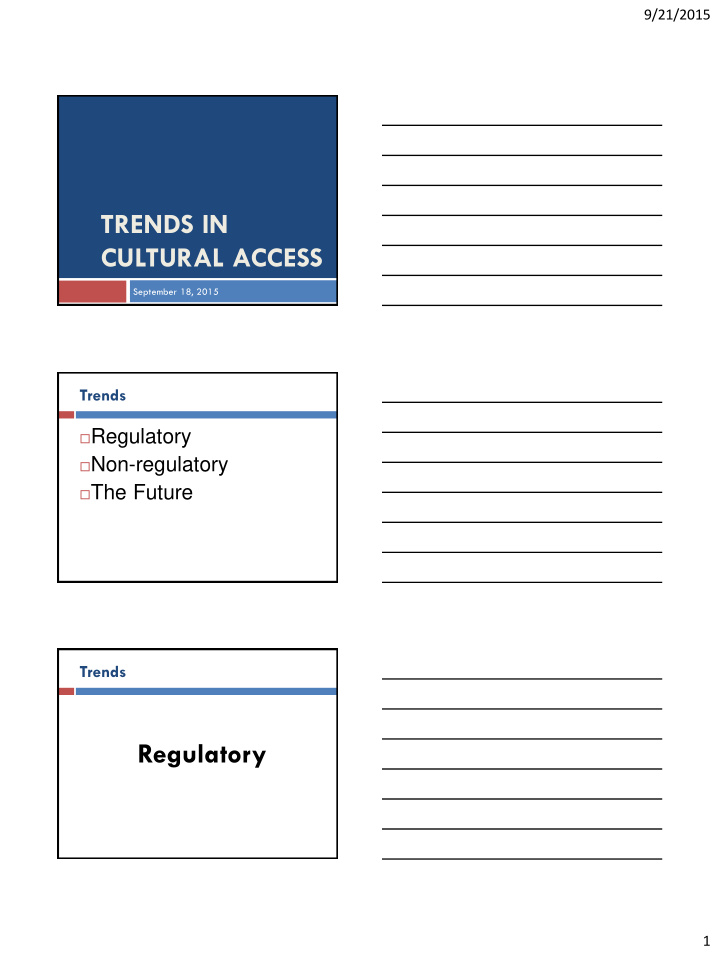



9/21/2015 TRENDS IN CULTURAL ACCESS September 18, 2015 Trends Regulatory Non-regulatory The Future Trends Regulatory 1
9/21/2015 2010 Revised ADA Regulations 1. Service Animal 2. Mobility Device 3. Ticketing 4. 2010 Standards 5. Safe Harbor 6. Reduction of Elements http://arts.gov/sites/default/files/NEA-ADA-TipSheet-v2.pdf Ticketing Regulations 1. Ticket sales 2. Identification of seating 3. Ticket prices 4. Purchasing multiple tickets 5. Hold and release of tickets 6. Ticket transfer 7. Secondary ticket market 8. Prevention of fraud www.ada.gov/ticketing_2010.pdf Trends Non Regulatory 2
9/21/2015 The Why – What Motivates Us Legal Requirement One Two: Economic/Business Sense Three: Part of the Mission Four: Right Thing To Do Five: Selfish Access Works When it --- Recognizes the diversity of needs within the disability community Integrates access into the fabric of the organization Changing Demographics 56.7 Million American’s with Disabilities (2010 U.S. Census) 19 percent of the population — nearly 1 – 5 people in the U.S. have a disability 8 % of children under 15 have disabilities. 21 % of people 15 and older have disabilities. 17 % of people 21 to 64 have disabilities 50 % of adults 65 and older have disabilities . As of 2008: 21 million adults have vision and 36 million have hearing loss 77.3 million Baby Boomers: In 2011 - The first of 77.3 million baby boomers turn 65 (approximately 25% of the total U.S. population) By 2030 there will be more people over the age of 60 than under the age of 30 3
9/21/2015 Customer Service Integrate access into Organizational the fabric of the Commitment organization through: Business Policies, Practice: Procedures Mission and value, Review and and Practice improve organizational commitment Business practice Community engagement Staff Buy- Policy, procedure and Community in/Empowerm practice Engagement ent and Training Staff buy-in, empowerment and training One Size Does Not Fit All Effective • Situation specific • Purpose, duration and complexity • Physical Access • Access is available to all visitors, all the time • Communication Access • Multiple modalities are used to communicate information Preference vs. Different Need Methods Accessibility Fundamentals Physical access Communication Access Interpreters Captioning Assistive Listening Sensory Friendly Audio Description Planning and Training 4
9/21/2015 Disability Specific Programming For example: Sensory Friendly Days/Early Openings at Museums and Performances Gallery Programs for People with Benjamin Catz-Hollander, 8, who has autism at an instrument petting zoo before the sensory-friendly Alzheimer’s concert at the Kennedy Center. “Music is just another way for us to connect,” said his mother. (Jahi Chikwendiu/THE WASHINGTON POST) Dance for Parkinson's Technologies Technologies 5
9/21/2015 Trends: What the Future Holds Engagement either in person or online (virtual, interactive, gaming, apps) Personalization of products, services, communications and experiences Handheld, mobile and wearable technologies Center for the Future of Museums www .aam- us.org/resources/center-for-the-future-of-museums Star Trek Contact information Betty Siegel Director of VSA and Accessibility The John F. Kennedy Center for the Performing Arts Washington, D.C. 20566 (202) 416-8727 (voice) (202) 416-8728 (TTY) access@kennedy-center.org Disclaimer Information contained in this presentation is for general guidance. The information in this presentation is not intended to be legal advice nor a rendering of legal advice, opinion or services. Recipients should consult with their own professional legal advisor. 6
Recommend
More recommend